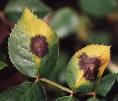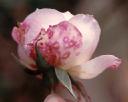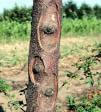Identification and Treatment of Diseases in Trees and Shrubs
Sooty Mold
Symptom: Only visible symptom is a black material covering the leaves.
Time: Summer
Damage: The black sooty look is actually caused by insects sucking on the leaves, leaving a Honeydew mold in its place. While the mold causes no permanent damage to the plant, it may not be pleasing to the eye.
Treatment: Control Aphid (insect) populations with a mild insecticide.

Sooty Mold
Baldo Villegas
Leaf Spot
Symptom: Spots on the leaves material
Time: Anytime throughout the year
Damage: Complete defoliation and if severe enough, plant death
Treatment: Improve air circulation, water in the early morning, and increase soil exposure by cultivating and turning over the soil.
Plants Affected: Most

Leaf Spot
Copyright © 2005
Purdue University
Rust
Symptom: Pale spot on leaves. Orange pustules (blisters) on underside of the leaf.
Time: Anytime throughout the year
Damage: Although not pleasant to look at, it causes no damage to your plants.
Treatment: Other than making sure your plants get good air circulation, control of this problem is normally not necessary.

Rust
Plant Disease Diagnostic
Lab at Kansas State
Crown Gall
Symptom: Galls (tumors) on the stems
Time: Anytime throughout the year
Damage: Can kill your plants if severe enough
Treatment: Catch as early as possible. Prune out the infected area, making sure to sterilize your tools between each cut.
Plants Affected: Euonymus

Crown Gall
Baldo Villegas
Powdery Mildew
Symptom: White powdery coating on the upper surfaces of leaves
Damage: Partial defoliation
Treatment: Since stressed plants are more susceptible to disease, make sure to water and fertilize and to prune properly for improved air circulation.

Powdery Mildew
Plant Disease Diagnostic
Lab at Kansas State
Anthracnose
Symptom: Rotting spots on leaves, stems or flowers
Time: Very early in a cool, wet spring.
Damage: Partial defoliation, rarely causing severe damage.
Treatment: Clean up plant debris. Spraying Copper Sulphate right when the leaves start to emerge will help.

Anthracnose
Copyright © 2005
Purdue University
Apple Scab
Symptom: Light gray spots on sepals (little leaf-like structures directly under the flower) or on the underside of the leaf. Spots on the fruit become corky.
Time: Infection occurs in the early spring but becomes obvious mid- to late-summer.
Damage: Partial defoliation; only the new growth retains the leaves.
Treatment: Make sure to plant disease-resistant varieties. Prune well to increase air circulation.
Plants Affected: Apple Trees, Hawthorns, Pear Trees

Apple Scab
The University of Minnesota
Extension Service
Black Spot
Symptom: Yellow spots on leaves turning brown and eventually black
Time: Summer.
Damage: Complete defoliation, resulting in the death of individual canes (stalks).
Treatment: Pick up all plant debris, cut out and destroy all infected parts of the plant (any debris left on the ground houses the spores throughout the winter, leaving them to return for more damage the next year). Avoid watering the leaves. A sulfur based fungicide will help control this problem.
Plants Affected: Rose Family

Black Spot
Baldo Villegas
Botrytis Blight
Symptom: Tiny, water-soaked spots appear. Then the spots enlarge and become soft and watery. Eventually, the infected stems turn light brown and crack open. Damage normally starts on the lower part of the plant.
Time: Early spring
Damage: The branches die back and if severe enough, the plant will die completely.
Treatment: Improve air circulation, clean up all old plant debris, and remove and destroy all diseased portions of the plant (again, the spores reside in the debris over winter).

Botrytis Blight
Baldo Villegas
Canker
Symptom: Long, sunken section of the branch or stem.
Time: Anytime throughout the year
Damage: Death of all branches eventually leading to the death of the entire
plant
Treatment: Cut out the infected areas at least 2 inches below the infected area, sterilizing the
tools between each cut.
Plants Affected: Dogwoods, Maples, Spruces, Mountain Ash, Poplars and Willows

Canker
The University of Minnesota
Extension Service
Fire Blight
Symptom: Sudden wilting of leaves, flowers, and even young stems. Leaves turn brown or black and curl upright. The branch looks as if scorched by fire.
Time: Anytime throughout the year
Damage: IMPORTANT!!! Your tree or shrub could die in as little as 2-3 days!
Treatment: Avoid over-fertilizing with nitrogen. Control insects as much as possible. Prune out and destroy all infected areas, disinfecting tools between each cut.
Plants Affected: Roses, Pyracantha, Apples and Pears.

Fire Blight
Copyright © 2005
Purdue University
Fusarium Wilt
Symptom: Wilting, even when soil is moist.
Time: Anytime of the year when there are moist, cool evenings
Damage: If severe enough, could kill the plant
Treatment: Plant in well-drained soil. Because high soil temperatures aggravate the problem, mulch wherever possible, since mulch decreases the temperature of the soil.
Plants Affected: Many plants including Bulbs, Shrubs and Trees.
Image not Available
Note: Although each of these diseases is different, you can greatly reduce the risk of disease for most of your plants simply by pruning to increase air circulation.